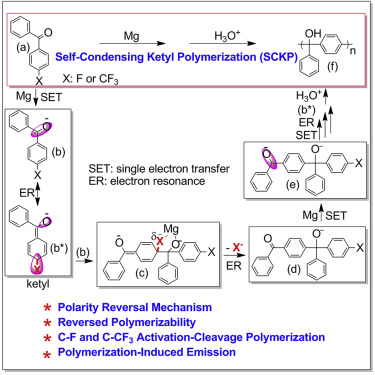iScience ( IF 4.6 ) Pub Date : 2020-04-05 , DOI: 10.1016/j.isci.2020.101031 Shun-Shun Li 1 , Nengbo Zhu 2 , Ya-Nan Jing 1 , Yajun Li 2 , Hongli Bao 2 , Wen-Ming Wan 1

|
Carbon-carbon bond formation through polarity reversal ketyl radical anion coupling of carbonyls has inspired new reaction modes to this cornerstone carbonyl group and played significant roles in organic chemistry. The introduction of this resplendent polarity reversal ketyl strategy into polymer chemistry will inspire new polymerization mode with unpredicted discoveries. Here we show the successful introduction of polarity reversal ketyl approach to polymer chemistry to realize self-condensing ketyl polymerization with polymerization-induced emission. In this polarity reversal approach, it exhibits intriguing reversed polymerizability, where traditional excellent leaving groups are not suitable for polymerization but challenging polymerizations involving the cleavage of challenging C-F and C-CF3 bonds are realized under mild Barbier conditions. This polarity reversal approach enables the polymer chemistry with polarity reversal ketyl mode, opens up a new avenue toward the polymerization of challenging C-X bonds under mild conditions, and sparks design inspiration of new reaction, polymerization, and functional polymer.
中文翻译:

巴比尔自缩合羰基聚合诱导发射:一种实现反向聚合性的极性反转方法。
通过羰基的极性反转羰基阴离子偶联形成碳-碳键激发了这一基石羰基的新反应模式,并在有机化学中发挥了重要作用。将这种出色的极性反转羰基策略引入聚合物化学中将激发新的聚合模式并带来意想不到的发现。在这里,我们展示了将极性反转羰基方法成功引入聚合物化学中,以实现具有聚合诱导发光的自缩合羰基聚合。在这种极性反转方法中,它表现出有趣的反向聚合性,其中传统的优异离去基团不适合聚合,但在温和的巴比尔条件下实现了涉及挑战性CF和C-CF 3键断裂的具有挑战性的聚合。这种极性反转方法使聚合物化学具有极性反转羰基模式,为温和条件下具有挑战性的CX键聚合开辟了新途径,并激发了新反应、聚合和功能聚合物的设计灵感。











































 京公网安备 11010802027423号
京公网安备 11010802027423号